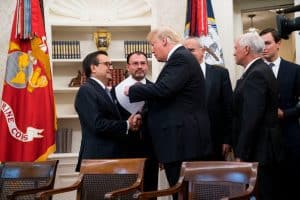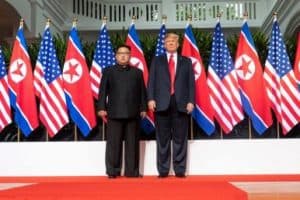
Handshakes on a US-Mexico trade agreement, part of NAFTA 2.0 negotiations (Doug Mills/NYT)
Trade correspondent L.C. reports: As expected, the US and Mexico this morning announced agreement on a trade deal which, if Canada accepts, will constitute NAFTA 2.0. “But a number of key factors remain unresolved in Trump’s effort to replace the North American Free Trade Agreement — the biggest among them whether Canada will sign on the deal. Trump and Mexican leaders also failed to resolve whether the U.S. tariffs on metals imports will remain in place,” today’s Washington Post reports.
For cars to enter the US duty-free, North American content is raised to 75%, and for steel, aluminum and glass, to 70%. Seven high-value car components must originate in North America (including the power train). On wages, the North American average is set at $16/hour and cars assembled by workers making a lower wage must have 40% of the final assembly work done by workers making at least $16 (45% for truck assembly). This is supposed to reduce flight of car makers from the US and Canada to lower-wage Mexico.
But the US seems to have dropped its earlier demand that NAFTA have a sunset clause whereby it would automatically expire after five years unless renewed by all parties. This provision was strongly opposed by businesses in all three countries because of the negative effect it would have on long-term investment.
Overall, a major thrust of the Trump approach to NAFTA 2.0 has been protectionist – to make it more attractive for manufacturing to locate in the US rather than in Mexico. Ironically, the mounting tariffs on Chinese imports may have the opposite effect: they make it more attractive for US companies to move to Mexico. There, they can import Chinese intermediate goods without the Section 301 tariffs and sell the finished product into the US market duty-free under NAFTA.
US-China trade confrontation mounts
The trade confrontation with China is poised to escalate further as bilateral talks this week resolved nothing:
- The US imposed the second tranche of tariffs – 25% on $16 billion of imports (270 products) from China, provoking an equivalent Chinese response;
- The US moved closer to imposing 10%-25% tariffs on a third tranche, comprising $200 billion in Chinese exports, as early as September; and
- Beijing is filing another WTO complaint against the new US tariffs.
US-EU-Japan meetings give promise of cooperation vs. Chinese abuses
Since the Trump Administration began its trade campaign against China, there have been calls – within the US and abroad – that it not take unilateral action but work with allies who share US concerns about China’s abusive trade and investment practices. This week gave promising signs that the US is attempting to follow this advice while continuing to move unilaterally:
- European officials came to Washington for the first meeting of the US-EU Executive Working Group set up at the July 25th Trump-Juncker summit; and
- Japanese officials joined EU and US officials for talks in Washington for the trilateral initiative the three countries set up late last year to cooperate on reforming the WTO and fighting China’s abuses.
Several European sources said the US is pushing for very rapid progress. The EU also wants things accomplished quickly because the European Commission must first get a mandate from member governments to negotiate and then will want to finish a deal before the next European Parliament elections in May 2019. Brussels is also eager for the process to move since President Trump promised to exempt the EU from any Section 232 auto tariffs as long as talks are progressing.
This relates directly to China because the Trump-Juncker agreement included a commitment to cooperate “with like-minded partners to reform the WTO and to address unfair trading practices, including intellectual property theft, forced technology transfer, industrial subsidies, distortions created by state owned enterprises, and overcapacity” – that is, to work to curb China’s abusive trade practices.
If the US should instead impose Section 232 tariffs on European cars, this cooperative process would hit a wall. Despite his deal with Juncker, that possibility was revived this week by President Trump, who told a political rally on August 21st, “We are going to put a tax of 25% on every car that comes in from the EU.” White House officials dismissed the remark as rhetoric, but it shows that German cars remain on the President’s mind.
Beijing does not want to face a united front of its main trading partners. There were recent reports that China proposed to the EU that it join China’s WTO complaint against the US Section 232 tariffs but was rebuffed, suggesting the EU is looking to stay closer to the US than to China (though Brussels independently filed its own complaint against the US tariffs).
Without strong Japanese and European support, the US would not have an easy time isolating and pressuring China. Its economy faces problems but probably not a severe downturn.
Mixed signals from the President
But the week also brought speculation as to whether the President really wants mutually agreed upon trade deals or whether he is just looking for ways to justify a permanent imposition of tariffs. Suggestive of how enamored the President is of tariffs were remarks he made at an August 23rd round table on foreign investment. He claimed that the tariffs imposed thus far are raising a huge amount of money and that the money is “coming into” the US – two wrong propositions. In terms of money of significance to the federal budget, tariff revenue is puny, and the revenue raised is raised within the US – from domestic importers.
The six days of public hearings on the pending Section 301 tariffs on $200 billion of Chinese exports conclude on August 27th. The hearings, with almost 400 witnesses, make plain that there is scant support for the escalating tariff war. The vast majority of witnesses and submitted comments oppose the tariffs, at least for specific products that businesses large and small, associations, and legislators claim would cause severe injury to specific US companies and industries. The initial two tranches of tariffs on a total of $50 billion in imports were structured to spare direct pain on consumers, but when another $200 billion are added, consumer items will have to be a large part of the mix. The hits to industrial inputs like chemicals and plastics and other intermediate goods have already caused pain to US manufacturers, and the third tranche will also continue to hit these, including auto parts, along with many consumer goods. China meanwhile is retaliating against imports of large US cars.

China isn’t helping any more (White House photo)
President Trump weighed in after the unsuccessful lower level US-China talks in Washington last week. His tweets surprised many for admitting that his trade policy is damaging his diplomacy. After reporting that he had cancelled Secretary of State Mike Pompeo’s planned trip to Pyongyang, he tweeted, “…Additionally, because of our much tougher trading stance with China, I do not believe they are helping with the process of denuclearization as they once were (despite the UN Sanctions which are in place)…,” an apparent admission that his expectation that he could leverage his tough trade policy to force Beijing to help the US with North Korea had backfired.
Click here to go to the previous Founders Broadsheet (“Can US education become great again?”)

Leave a Reply